Gymnasium



In the pages that follow, we invite you to imagine how these design interventions will impact Riley, an imaginary—but very real—student.
We owe it to students like Riley to make school buildings as inviting, safe, and healthy as they can be.
Follow Riley’s journey through school at healthyk12.perkinswill.com/


• Students who are physically active tend to have better grades, school attendance, cognitive performance (e.g., memory), and classroom behaviors (e.g., on-task behavior).
• Less than one-quarter (24%) of children 6 to 17 years of age participate in the recommended 60 minutes of physical activity every day.
• School-based programs can contribute to physical activity levels, both during youth and later in life.
― Though many of the strategies we discuss in this Fitness Space report apply to most K-12 schools, there are substantial differences between the fitness space programming needs at different education levels. To generalize to as many K-12 schools as possible, this report does not cover natatoriums or other sport-specific areas. We encourage design practitioners to engage with stakeholders to understand the unique physical activity considerations for their site.
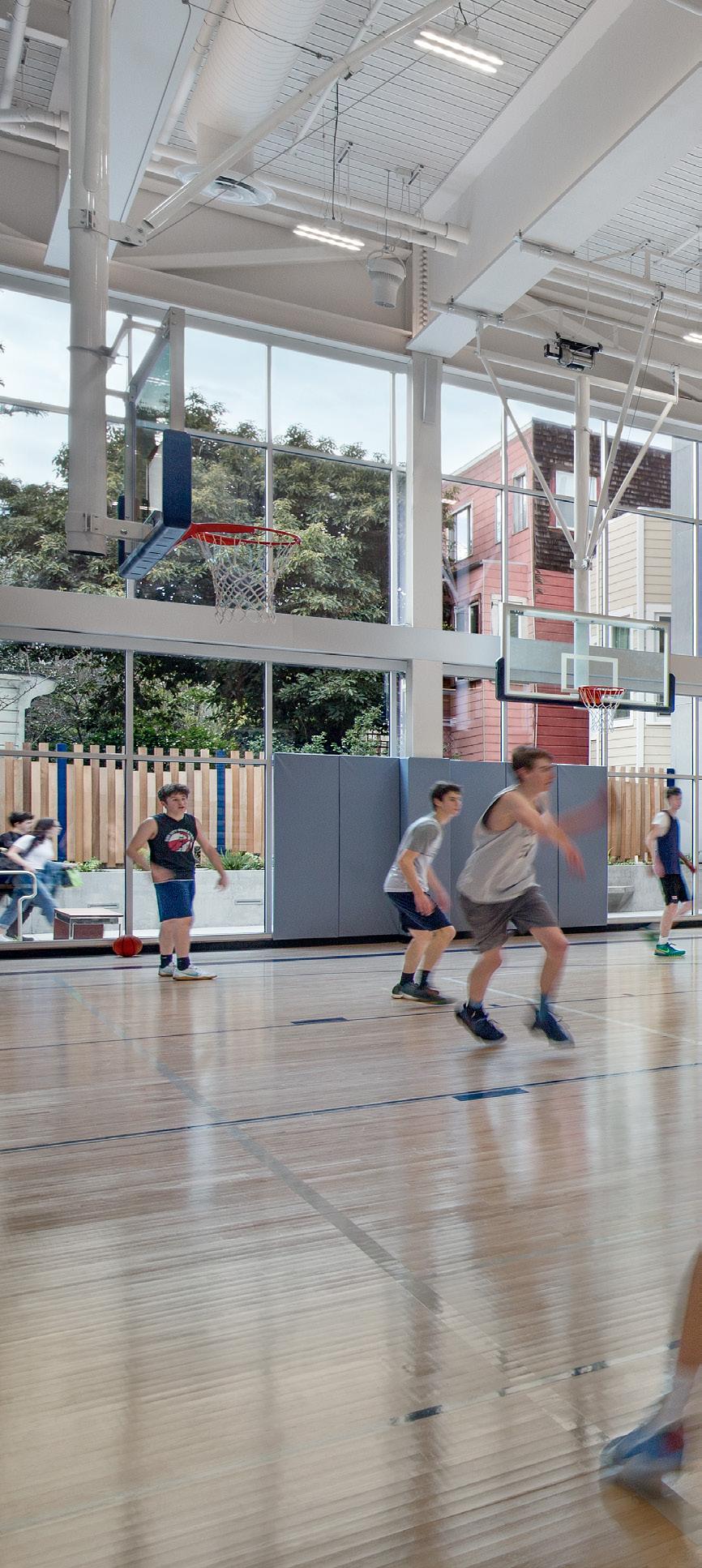
This series translates research into practical design solutions that promote child and staff health in our K-12 schools. The guidance provided does not replace federal, state, or local public health recommendations and aggregates best practices and innovative solutions at the intersection of buildings and school health. These documents will continue to be updated to reflect novel findings and community input.
Our goal is to identify opportunities where design and operations decisions can improve human experience. This primer is not a comprehensive list, and some strategies may not be achievable in existing buildings. We encourage schools to reach out and seek expert advice on their unique circumstances.

Install roll-down gym divider curtains for flexible teaching spaces
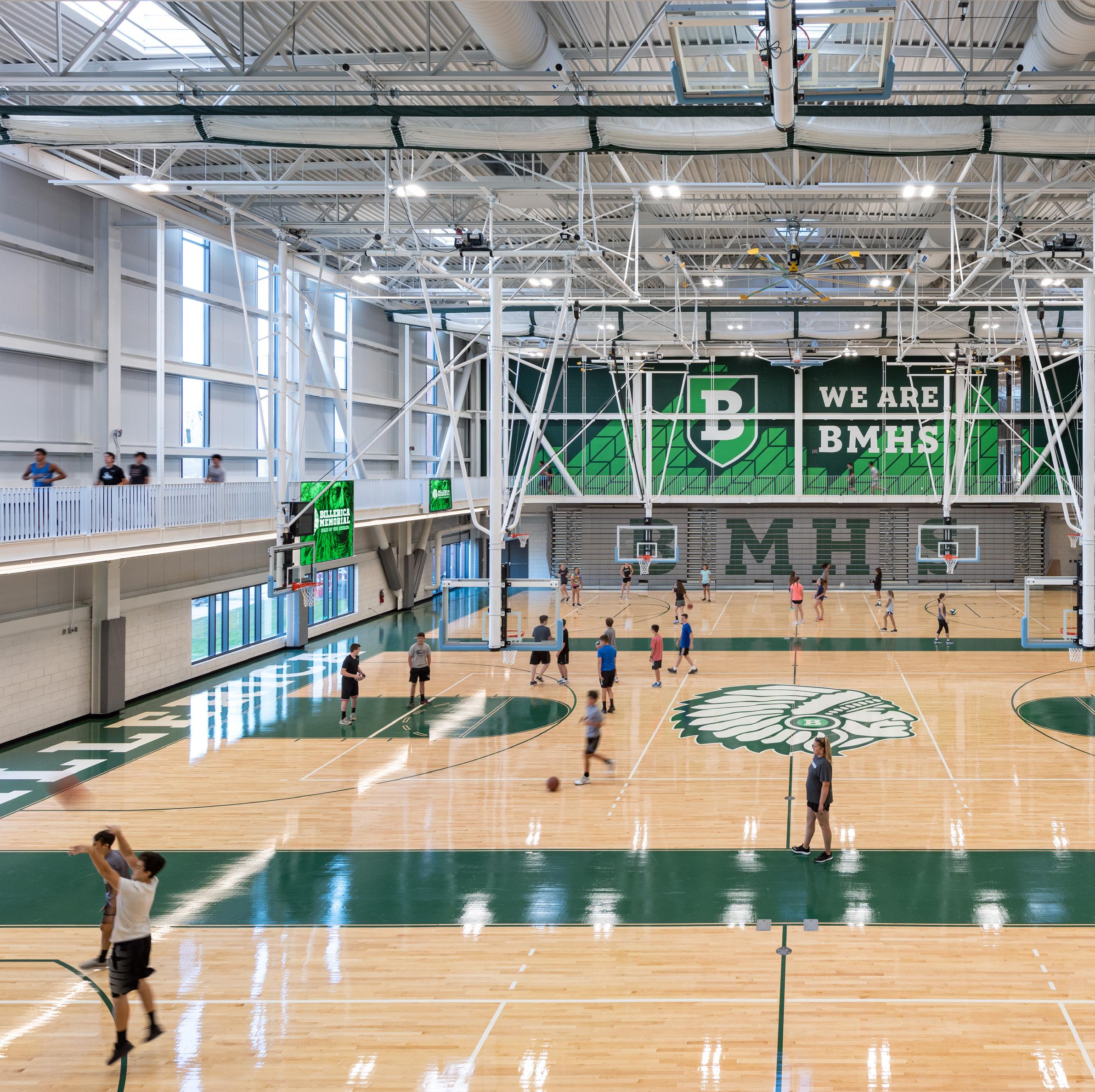
Provide windows for natural light and views
G.10
Use branding to promote sense of community
Project: Billerica Memorial High School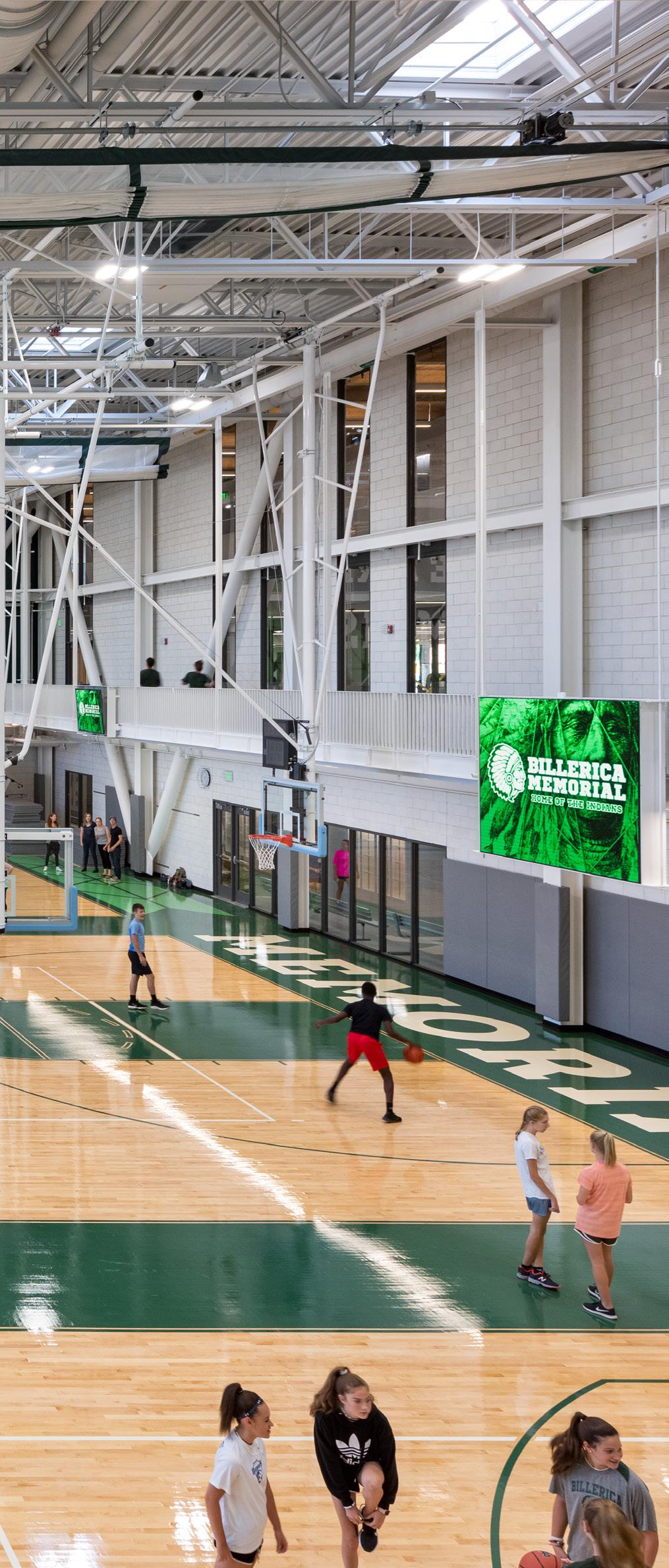
When the first high school gymnasiums were built in the U.S. early 1900s, they quickly became places for community gathering outside of athletics. This has continued today, since we see physical activity spaces serving multiple community needs. Gyms may serve as community shelters during natural disasters and extreme temperatures. They are often used for large school events, such as outside speakers and graduation ceremonies. Additionally, public use may also extend to outside sports leagues and local entertainment.
Our strategies reflect the flexibility required of a typical gym space, though practitioners should explore the unique needs of their own communities.
Gymnastics, hygiene, and care of the human body were introduced to the U.S. primary school curriculum. Round Hill School in Northampton, Massachusetts officially added these courses to their educational offerings in 1823, the first school to do so.
Immigrants from Germany, Sweden, and England introduce popular European activities to the United States, including gymnastics, team sports, and calisthenics.
Local and state school systems begin requiring physical education courses. The city of Cincinnati, Ohio was the first school system to provide a physical education program in 1855, while the State of California required schools to implement two daily exercise sessions in 1866.
Post-WWI, physical activity grows to become an integral part of public school education. In 1927, a group of famous educational psychologists publishes, The New Physical Education. Gymnasiums become common in public high schools.
Three major reports are released in the United StatesThe Surgeon General’s Report on Physical Activity and Health (1996), Healthy People 2000 (1990), and the CDC’s Guidelines for School and Community Programs (1997) - reflecting the rise in inactivity and obesity among U.S. individuals.
The Second World War further prompted physical education, as the U.S. sought to prepare young men for the physical demands of military service. Physical education begins to focus more on cardiovascular fitness than team sports. The President’s Council on Physical Fitness was formed to address inactivity among U.S. youth.
Today
With a renewed emphasis on disease prevention, school systems are re-evaluating their physical education programs. The COVID-19 pandemic encourages schools to be more accountable and creative in their programming.
School gymnasiums must start with an optimed physical environment if we are to expect healthy behaviors and outcomes for students, staff, and community users. Some environmental design and maintenance considerations include:
Due to activities that require heavy breathing associated with physical activity, sports, and play, students are more susceptible to indoor environmental quality. When gymnasiums also host sporting events or community meetings, these large gatherings can reduce social distance and make viral transmission more likely during winter events. In a review of indoor environmental quality in sports facilities, multiple pollutant sources were identified and could be considered in your own school including formaldehyde in finishes, NOx from outdoor road traffic, and acetone in common cleaners and polishes. In a study on IAQ during wrestling matches, high carbon dioxide and dust levels were measured. Also, in older school buildings, deteriorating building materials like lead and asbestos may still be present in dust and can be inhaled while exercising. In October 2022, asbestos was uncovered in a high school gym in Fairfield, California, where school officials did not know they were being exposed or the level of deterioration. Improving air filtration and ventilation systems and the use of lowemitting materials finishes and cleaners can help improve common respiratory health issues.
The water quality in gymnasiums and sports facilities should be tested regularly to ensure that it is safe for use. In plumbing systems older than 1991, lead may be found in locker room showers, water fountains or sinks. Also, swimmers and community members who regularly use pools and other aquatic facilities may be impacted by biological and chemical toxicants. Highly chlorinated pools can lead to respiratory problems, especially in poorly ventilated spaces and for individuals with asthma.
The presence of moisture due to leaks and high humidity can lead to mold and warping of hardwood floors in gymnasiums. In December 2022 in Canandaigua, NY, a HVAC system above the gymnasium failed, causing hot water to leak and melt the wax on the hardwood floor until it required replacement. This is a visible sign that moisture impacts our use of indoor sport facilities, but excess moisture can lead to mold growth which may not always be visible but can exacerbate asthma.
High noise levels, reverberation and echo can lead to discomfort in gymnasiums and sports facilities. Noise can be created by physical activity, music playing, mechanical systems, noise outside, and spectators, which may be amplified by hard surfaces throughout the large, open space. For teachers and staff, who work in the gymnasium regularly, the constant noise, which can exceed 80 decibels, have been associated with heightened risk for hearing loss. Using acoustical dampening on ceilings and walls may improve acoustics.
Students using the gym may exercise or play on the floor and are exposed to pesticides that may be used to manage rodents and pests. Pesticides may be applied indoors or outdoors (agricultural) but they can migrate in and integrate into gymnasium dust and mats causing students to inhale, ingest, or touch these contaminated surfaces. To control the pesticides applied indoors, use integrated pest management protocols can reduce exposure to harmful chemicals.
In older gymnasiums, building materials and finishes can contain harmful legacy pollutants from decades before such as mercury which was applied to gym flooring to make it more durable to daily wear and tear. However, over time the flooring surface may deteriorate and result in mercury to be released into the air. Gym teachers are frequently in the gym for long durations over the course of their career. In the case of a New Jersey gym teacher, she believed her diagnosis of a rare kidney cancer at age 36 was associated with the rubberized floor in her gym.
Gymnasiums
• How does lighting impact student experience in gym class?
• How does lighting impact student experience in gym class?
• Are students impacted by glare, lighting pattern, presence of windows in gymnasiums?
• How can artificial and natural lighting be optimized for student and staff health and well-being?








As a key opportunity for physical activity, K-12 schools may play a critical role in improving youth health and well-being. Habits formed in childhood and adolescence influence future physical activity across the lifespan.
Creating a school environment that promotes health requires a nuanced approach. However, a systematic review suggests students who attend “schools with larger yards, more facilities and recreational space, sports policies, and active setting” had higher physical activity levels than students in traditional schools. In another systematic review, however, there was insufficient evidence to suggest specific attributes of the school environment impact obesity.
Though more research is needed to understand the characteristics of fitness environments, it is clear that access to physical activity facilities is related to increased physical activity and reduced instances of adolescents who are overweight. However, these facilities are not always accessible to all. Low-SES and high-minority groups are less likely to have access to recreational facilities.
Individuals with disabilities may also have limited access to the full range of physical activities in school. The focus of adapted physical education (APE) has largely been skill development and/or modification of traditional sports and games, rather than promotion of physical activity.
Compared to children with typical development, children with disabilities often have delayed gross motor skills, challenges in balance and coordination, and poor cardiovascular fitness. These disparities can be addressed by improving opportunities for participation in physical activity. In fact, the CDC recommends physical activity for those with disabilities, as physical activity can help improve stamina and muscle strength, reduce symptoms of anxiety and depression, as well improve mood and feelings of well-being.
Regardless of physical fitness milestones and athletic ability, most physical education programs also emphasize building interpersonal skills. Life skills development is a key outcome across all ages. Among younger children, participation in physical activity programs can improve moral reasoning and prosocial behavior. In older students, team-building programs can improve feelings of self-worth, competence, and acceptance
The psychosocial benefits also extend to academic achievement as these programs can help students feel more competent in their academics and even improve academic performance. These benefits are even seen when traditional academic teaching is decreased in favor of increased physical education.
In 2020, Marlon Mussington, Lisa Roberts, Dr. Sharon Taverno Ross, and Lauren Wheeler helped us understand the role of physical activity in children’s health and wellbeing.
Check it out here!
Individual state policies mandate the amount of time required for physical education. However, the actual time allocated is left to the discretion of local education officials. Since the 2001 signing of No Child Left Behind Act, nearly half of school administrators reported cutting significant time from physical education to increase time in the traditional classroom setting.
Compared to other developed nations, the US ranks low on most measures of health. In fact, according to the CDC, there are 14.7 million obese children and adolescents in the United States. Obesity was most prevalent among children of color, a trend that continues into adulthood.
The COVID-19 pandemic highlighted this ongoing issue. A study of 432,302 children ranging from ages 2 to 19 found the rate of body mass index (BMI) increase nearly doubled during the pandemic. This health crisis is impacted by several factors including behavior, genetics, and access to healthy foods. The pandemic emphasized the opportunity for schools to promote healthy lives for children.
“Physical fitness is not only one of the most important keys to a healthy body, it is the basis of dynamic and creative intellectual activity”
JOHN F. KENNEDY
Strategies
Our aim is to support holistically healthy buildings, but we understand that each learning community is unique and has their own health priorities. Use these strategies as a starting point!
G.1 In order to achieve equity, flexibility and space efficiencies place the boys and girls lockers in front of the changing rooms, showers and team rooms for an allgender environment.
G.2 Provide windows in the gym for natural light and views beyond to enhance and support a variety of uses (community, performances, teaching, and collaboration).
G.3 Minimize glare inside the gym through the implementation of exterior shading devices and interior light shelves.
G.4 Ensure that the gym can be used for teaching and learning by providing wireless technologies, hard wired data ports and ample power to support student devices and portable interactive flat screens.
G.5 Ensure that WiFi is extended to the sports fields for educational, recreational, and safety purposes.
G.6 Large gyms can serve the community in the event of an emergency or environmental concern. Ensure adjacency to toilets, showers, and kitchen. Provide a storage room for cots, medical supplies and food.
G.7 Allow the gym to be easily partitioned off from the rest of the building for secure after-hour access.
G.8 Install roll-down gym divider curtains for flexible teaching spaces.
G.9 In the event of emergency, the gymnasium generator should support lighting, plumbing, power, heat, ventilation, and AC.
G.10 Develop branding and messaging in the gym that supports inclusivity, diversity and a sense of community pride.
G.11 Provide signage and technology to promote health + wellness with messaging like “Walking helps your heart to be more efficient, bringing more oxygen and nutrients to your organs” to not only educate students, but also encourage healthy behavior.
Gymnasium
The gymnasium can be a space for more than physical exercise. Every student can develop lifelong habits of health and wellness through exercise, less screen time and formation of positive relationships.
Our Sports, Recreation and Entertainment (SRE) team creates community spaces focused on well-being as inspired by sports, health, performance, and fun. We can apply the same thinking to our school gymnasiums. The shared use of physical education facilities can provide safe and affordable places for the community to come together.
Public recreation centers play a crucial role in developing healthy communities and enhancing the physical environment. These centers support healthy behavior for people of all ages, abilities, socio-economic backgrounds and ethnicities. As pillars of the community, recreation centers impact more than physical health. Many provide college prep through tutoring, as well as leadership opportunities for students to grow and develop personal character. Health is just one-third of the focus.
Public schools are located in all communities and typically have gymnasiums that can be shared with the community. The shared use of these facilities provides safe and affordable places for the community to not only be physically active, but to also gather as one.
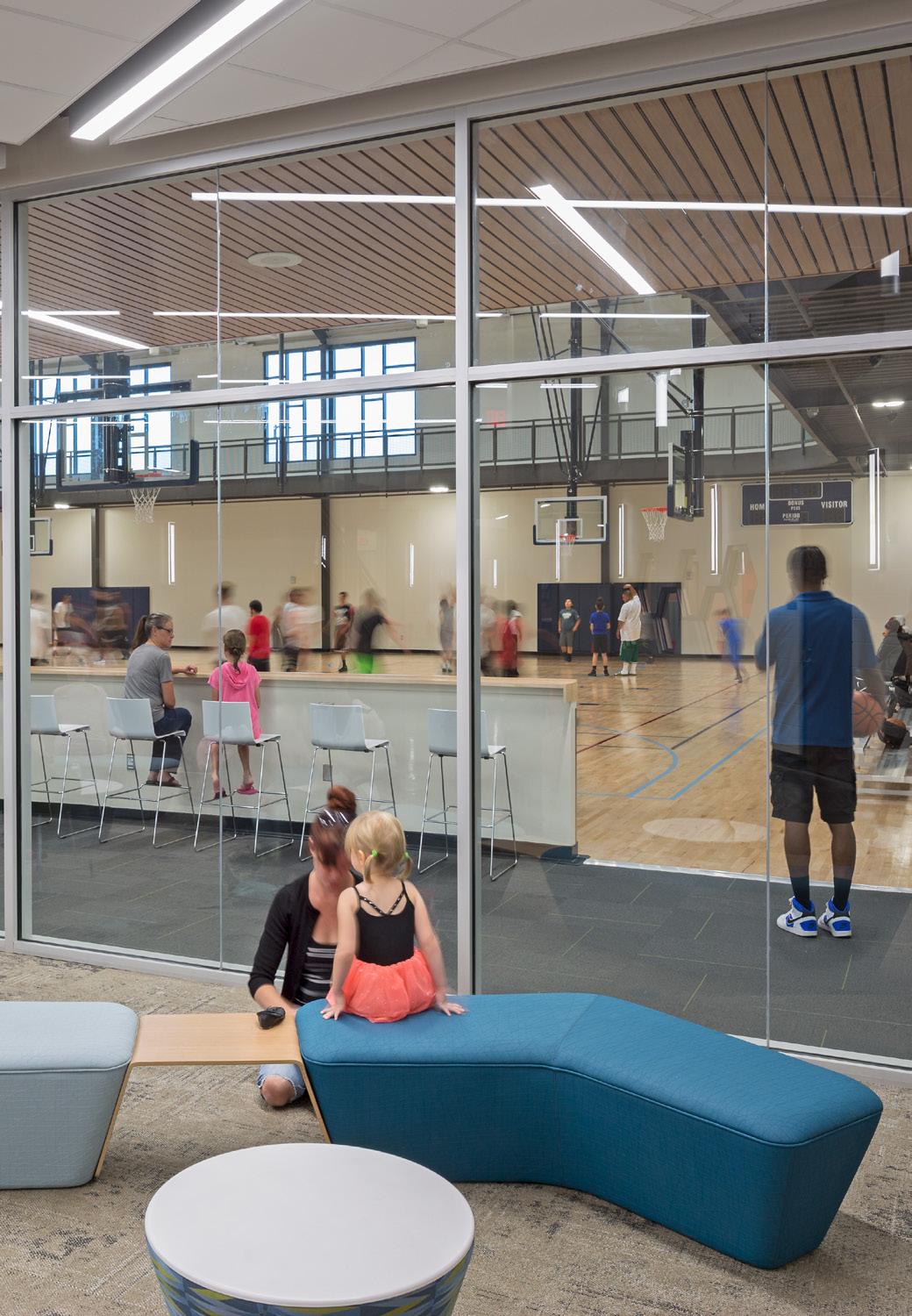
The American Heart Association (AHA) provides the following recommendations for federal, state, and local decision-makers to support the shared use of school spaces through the following strategies:
1. School Funding - Encourage or require school districts to provide community recreational use of school property
2. School Board Policy - Require school board policy to address shared use
3. Liability Protection - Clarify or provide liability protection for schools when recreational use of property is allowed
4. Shared Use Agreements - Authorize school districts to enter into shared use agreements and set specific requirements
5. Insurance - Require proof of insurance for groups using school property
6. Land & Water Conservation Fund - Support full and dedicated funding for the Land and Water Conservation Fund
7. Comprehensive Outdoor Plan - Incorporate community recreational use of school property as a Statewide Comprehensive Outdoor Recreation Plan priority
8. Incentives - Provide incentives for shared use in school construction
9. Joint Power Concepts - Outline joint powers concepts and opportunities
10. State-Level Toolkits - Require the creation of statelevel toolkits and local dissemination plans to local communities
At Phillips Academy, the school athletics motto is “Exercise for All”; a motto reflected in the requirement that all students participate in an athletic activity each semester. The Snyder Center not only provides state-of-the-art venues but also includes fitness studios and multi-purpose areas that serve the community. To promote an inclusive environment dedicated to making the student body feel welcome and well-represented, the facility is comprised of a series of interlocking, transparent, and inviting student activity spaces. As a result, this building acts not only as an athletic facility, but also as a Student Center and hub for student activity.
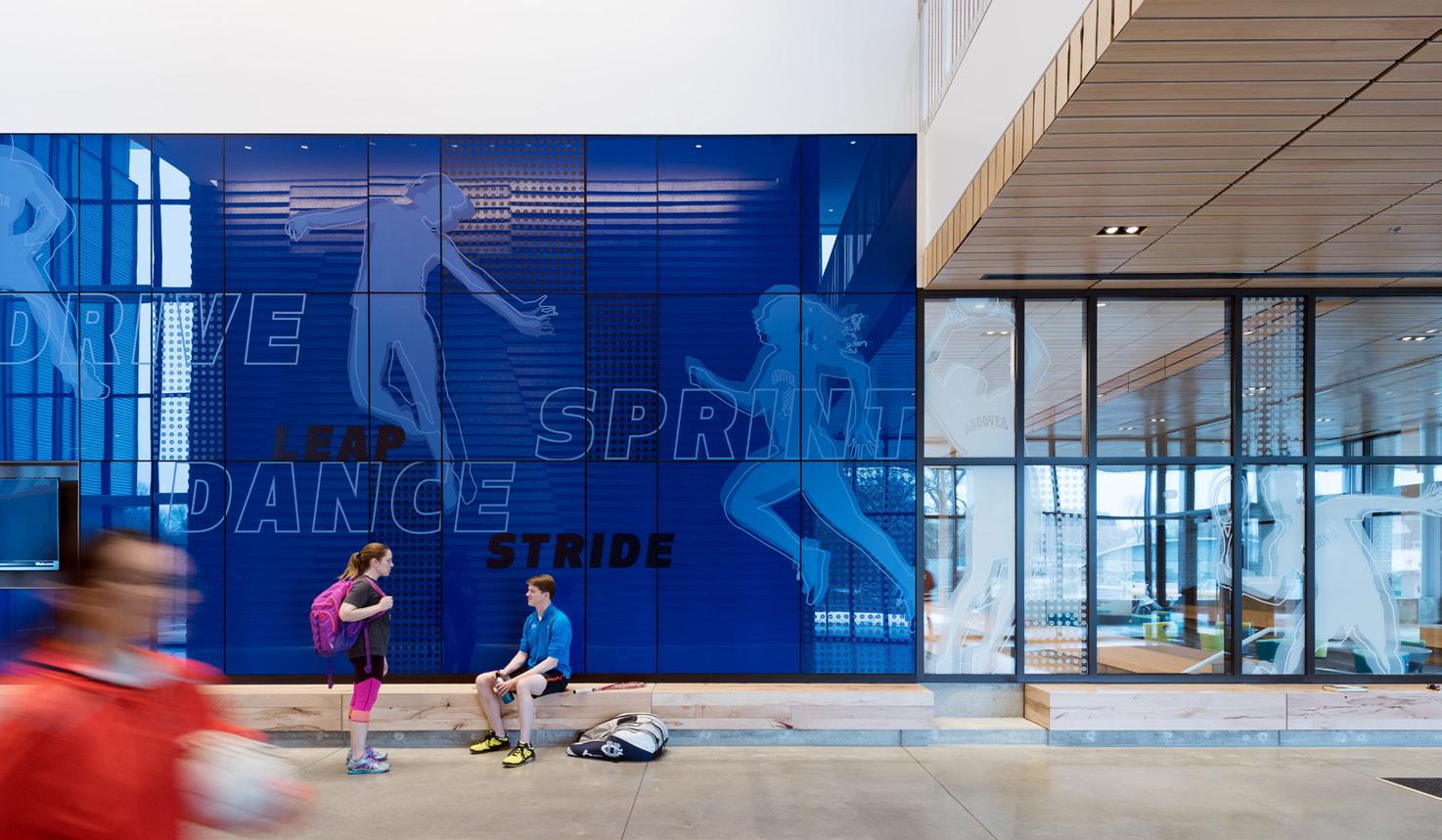
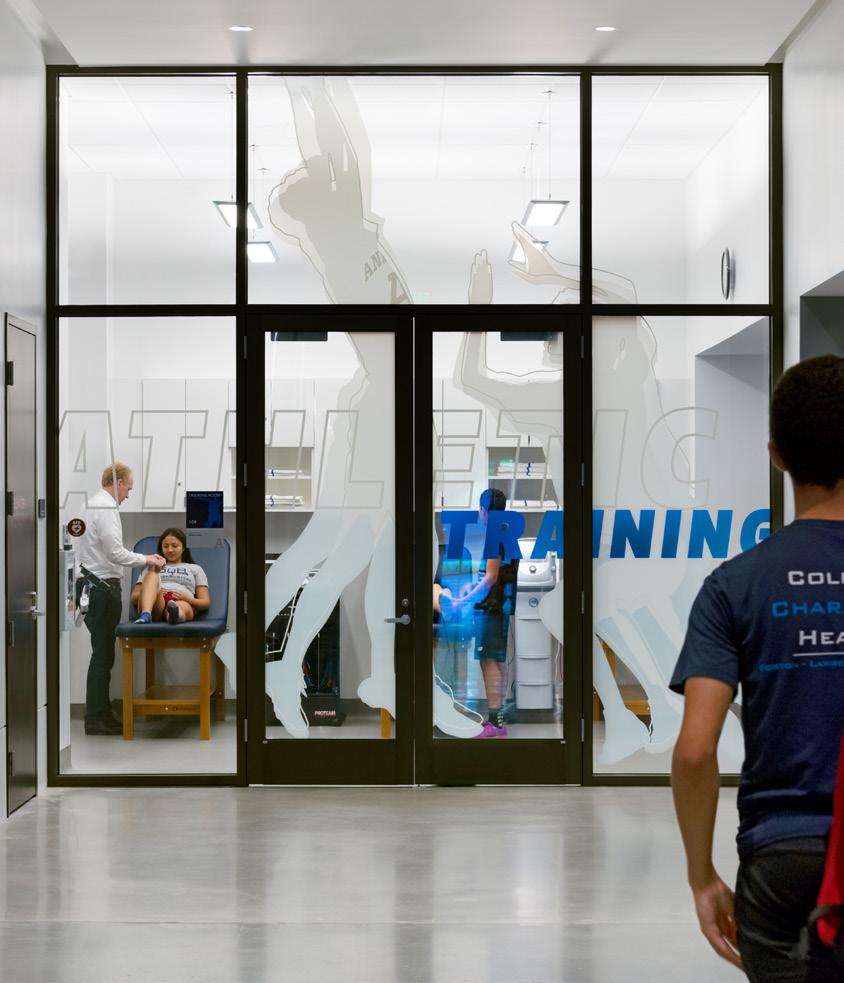
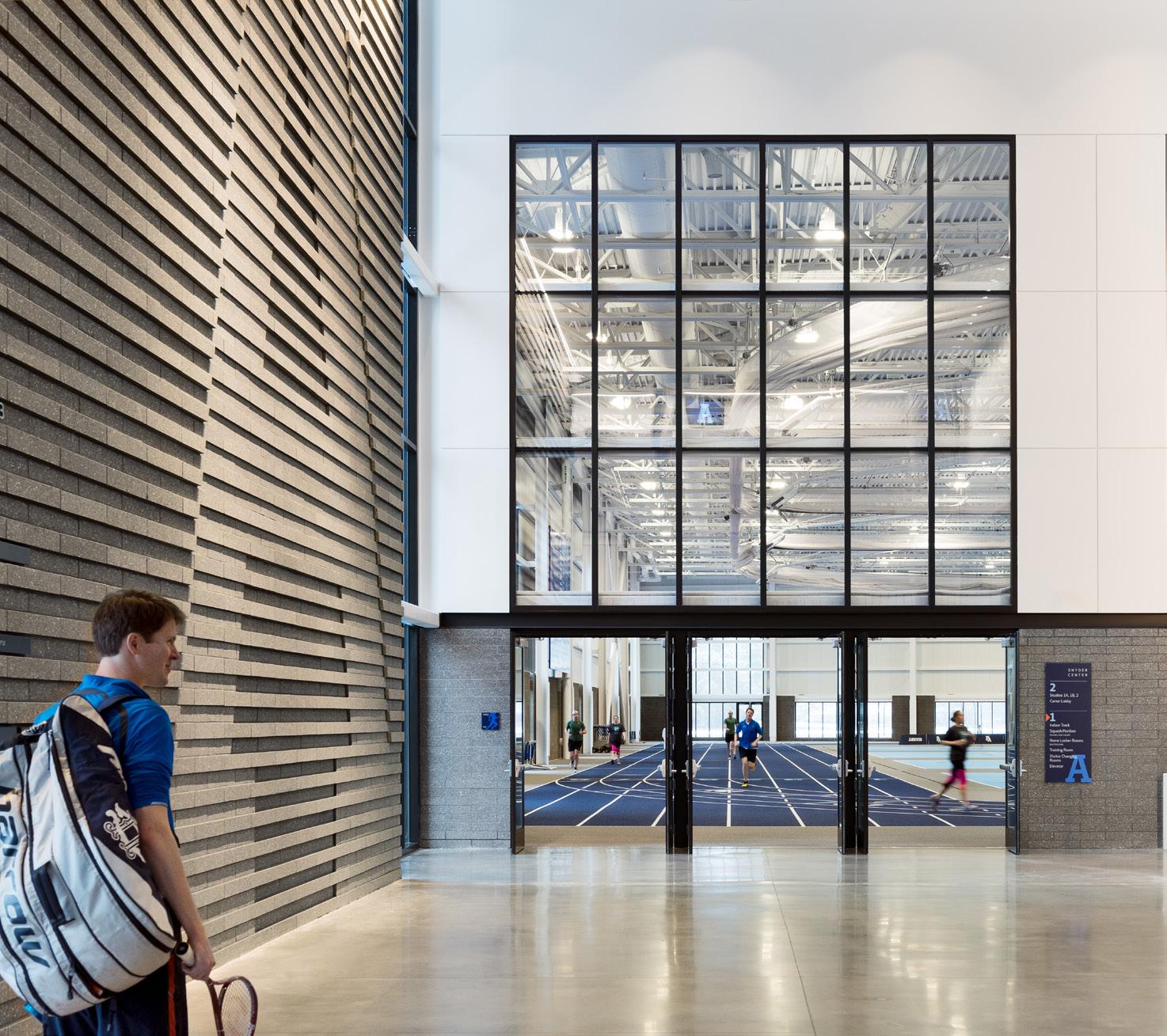
The combination of this array of program elements reflects the school’s commitment to inclusivity and fostering “spaces for all.”
The multi-use complex has a variety of scale of spaces ranging from inclusive student lounges to team meeting spaces to even an indoor track area. This building serves as a strong example of how a field house can be more than just a place for sports and recreation - but a student center for all at its core.
To highlight the school community, branding and graphics depict and represent all activities that could take place in the building for people of all kinds. Graphic messages in a variety of forms adorn surfaces to promote school spirit through sports and physical activity. Studies have shown repeated exposure to graphic messaging can impact behavioral decision-making. While many studies focus on motivational signage to promote stair usage, the signs proved effective in changing behavior. Incorporating graphics offers an opportunity to promote belonging and inclusion within the school setting, while also encouraging healthy behavior.
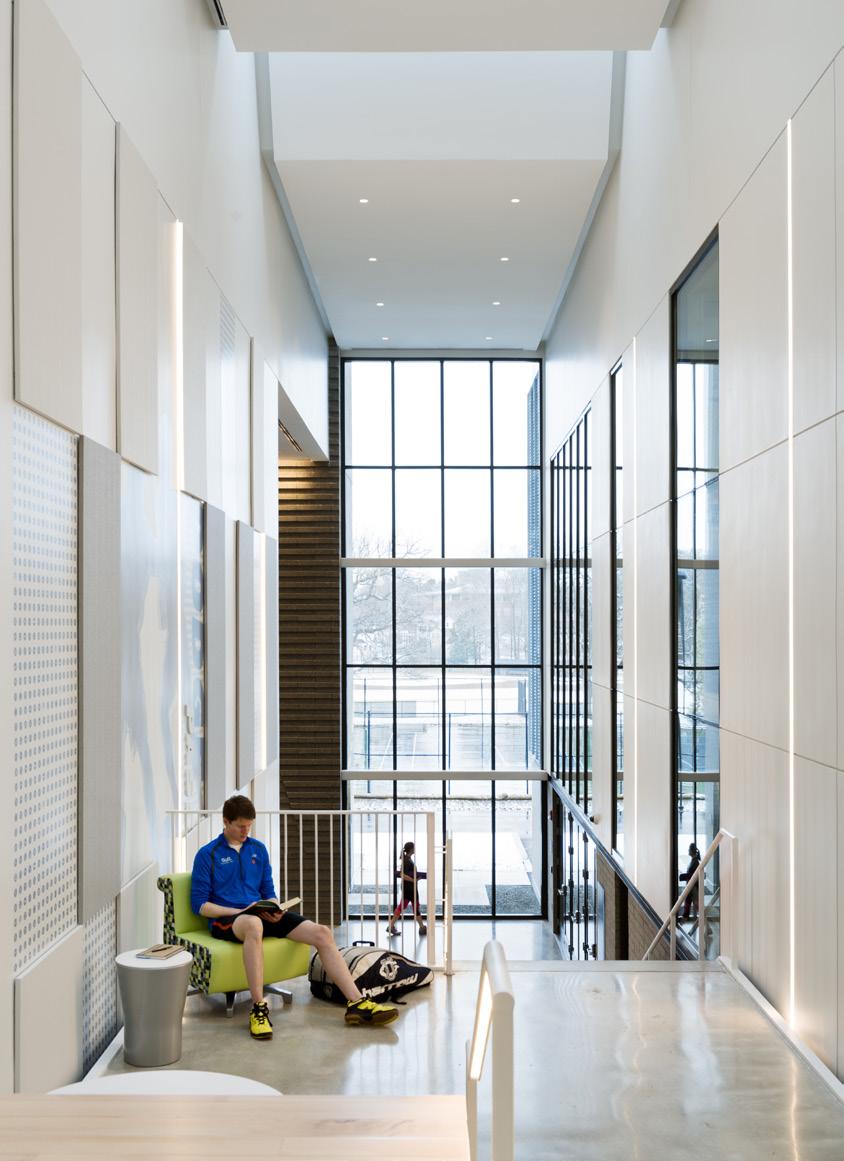
“This is not just an athletic facility, it’s a hub of activity for all of our students whether to come play, watch or just study.”
LEON MODESTE, PHILLIPS ACADEMY ANDOVER DIRECTOR OF ATHLETICS
education classes.
However, for students of the LGBTQIA+ community, entering the locker room can be a daunting experience. Many schools pose stringent rules on which room should be used, regardless of gender identity.

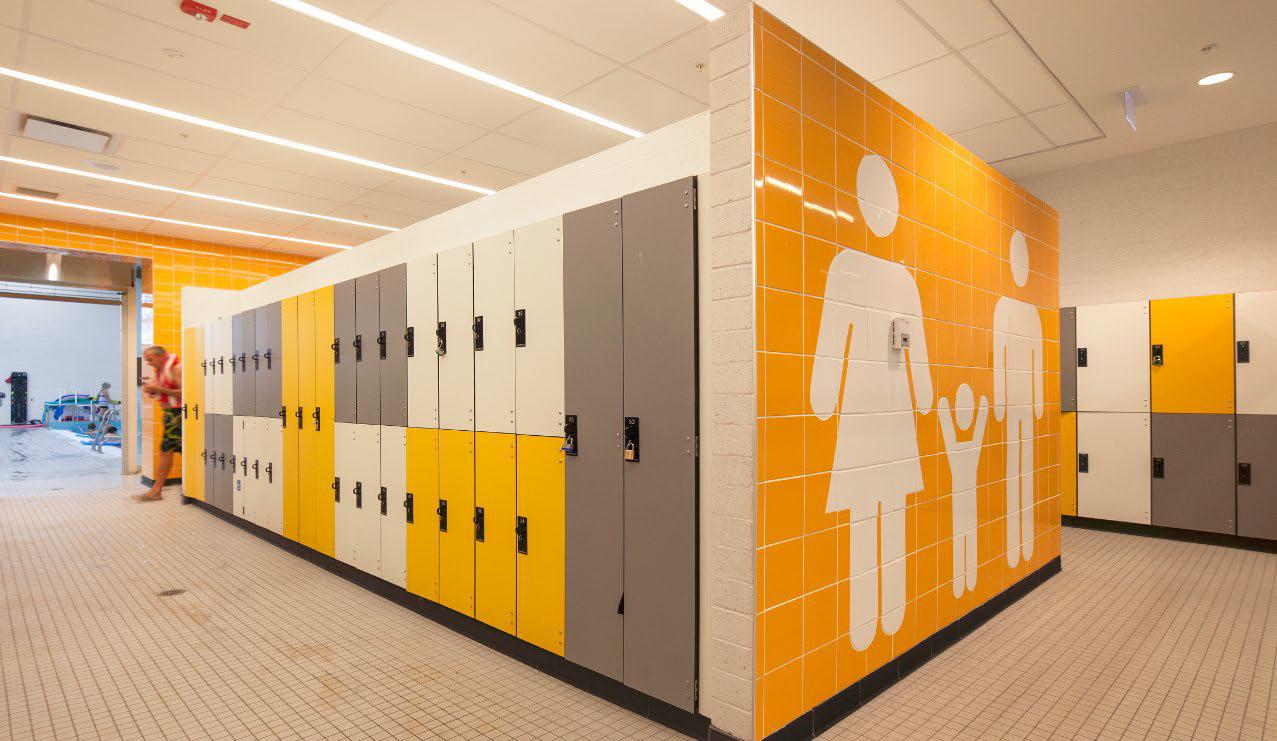
Studies show transgender and gender nonbinary students experience high rates of bullying. In fact, the National Center for Educational Statistics noted that 12 percent of bullying occurs in the bathroom or locker room.
The locker room acts as a gateway to participate in physical education, yet little attention is paid to the space from a diversity and inclusion perspective.
Professor Caroline Fusco from the University of Toronto highlighted the issue with her art installation, the Change Room Project. Fusco hopes the project will “build awareness of the experiences of LGBTQ students in athletics and recreation spaces. In representing student experiences in their own words, we hope to shift behaviors and attitudes in locker rooms to be more inclusive, accepting, and reflective, and to advocate for more all-gender spaces that provide options for safer, more inclusive spaces.”
Creating these inclusive spaces requires dealing with barriers, such as school support and code variances. However, doing so sends a message to the school community for equality for all students.

Inclusive locker rooms and restrooms extend beyond the coversation of gender inclusivity. Our research has redefined “healthy and inclusive” beyond the mainstream definition. Our holistic approach considers gender, in addition to physical and mental accessibility, age and development, personal identity (culture and behavior), and religion.
Gymnasium
One entry to locker room suite
Lockers for storage near entry
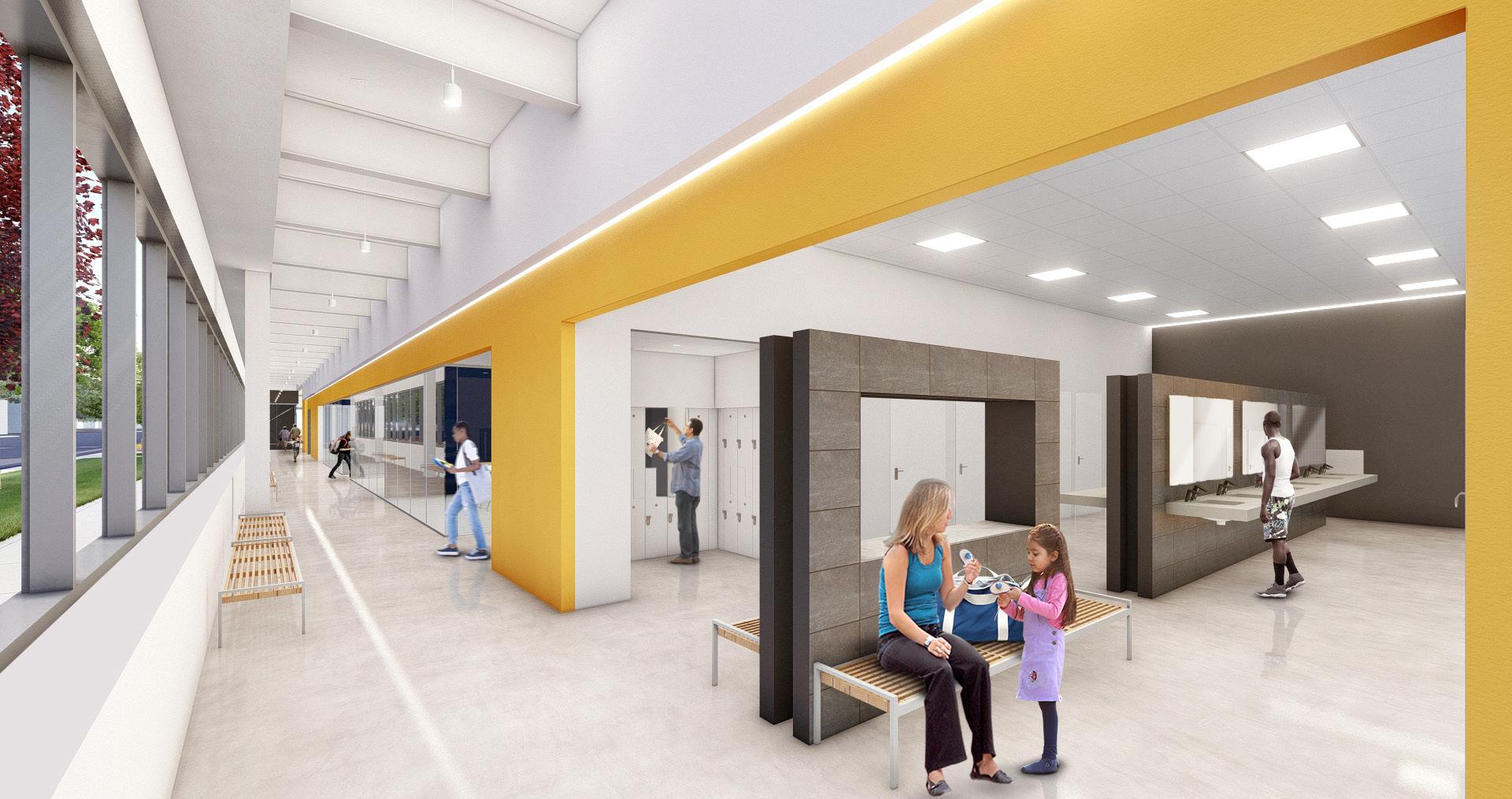
Individual wash rooms
No urinals in locker room suite
Shared sinks
Individual changing rooms
1. American Public Health Association. (2022). Health Rankings. APHA.org., https://www.apha.org/topics-and-issues/health-rankings
2. Bay City News. (2022). Asbestos fibers detected in Armijo High School gymnasium. NBC Bay Area. https://www.nbcbayarea.com/news/ local/north-bay/asbestos-armijo-high-school-fairfield/3022220/
3. Boyce, B.A. (2003). Physical education: Overview. In J.W. Guthrie (Ed.). Encyclopedia of Education (2nd ed.). (pp. 1886-1890). Macmillan References. Center for Disease Control and Prevention. (2022). Children, Obesity, and COVID-19. Overweight & Obesity: Obesity and COVID-19. https://www.cdc.gov/obesity/data/children-obesity-COVID-19.html
4. Carvalho, A., Barreira, C. (2014). Sound and noise in high school gymnasiums. The Journal of the Acoustical Society of America. Doi: 10.1121/1.4877632
5. CDC. (2022). Prompts to encourage physical activity. CDC: Physical Activity. https://www.cdc.gov/physicalactivity/communitystrategies/prompts-to-encourage-physical-activity.html
6. Centers for Disease Control and Prevention. (2022). Childhood Obesity Facts. Overweight & Obesity Data and Statistics. https://www. cdc.gov/obesity/data/childhood.html
7. Chawla, N., & Thamarangsi, T. (2014). Effectiveness of school built environment on physical activity in children: A systematic review. Journal of Health Science, 23(4), 14.
8. Dweck, C. (2002). Chapter 3- Messages that motivate: How praise molds students’ beliefs, motivation, and performance (in surprising ways). Improving Academic Achievement: Impacts of Psychological Factors on Education. https://doi.org/10.1016/ B978-012064455-1/50006-3
9. Ebbeck, V., & Gibbons, S. L. (1998). The effect of a team building program on the self-conceptions of grade 6 and 7 physical education students. Journal of Sport and Exercise Psychology, 20(3), 300-310.
10. Environmental Protection Agency. (2022). Introduction to Integrated Pest Management. Managing Pests in Schools. https://www.epa. gov/ipm/introduction-integrated-pest-management
11. Evans, D., Blitstein, J., Vallone, D., Post, S., Nielsen, W. (2014). Systematic review of health branding: growth of promising practice. Translational Behavioral Medicine- Oxford University Press. https://www.ncbi.nlm.nih.gov/pmc/articles/PMC4332908/
12. Fischer, J., Bayer, C. (2003). Humidity control in school facilities. Proceedings of the ICE. http://www.doas-radiant.psu.edu/Fischer_ Article_on_School_IAQ_03.pdf
13. Fletcher, L., Nejman, A., Smith, S., Deal, L. (2022). New details: PE teacher diagnosed with rare cancer at 36 warns about mercury in gym floors. The National Desk. https://kmph.com/news/nation-world/new-details-pe-teacher-diagnosed-with-rare-cancer-at-36warns-about-mercury-in-gym-floors-cancer-causing-gymnasium-floors-rare-phenylmercuric-acetate-cory-booker-new-jerseytoxic-dump-wast-site-schools
14. Gibbons, S. L., Ebbeck, V., & Weiss, M. R. (1995). Fair play for kids: Effects on the moral development of children in physical education. Research Quarterly for Exercise and Sport, 66(3), 247-255.
15. Gordon-Larsen, P., Nelson, M. C., Page, P., & Popkin, B. M. (2006). Inequality in the built environment underlies key health disparities in physical activity and obesity. Pediatrics, 117(2), 417–424.
16. Gould, D., & Carson, S. (2008). Life skills development through sport: Current status and future directions. International Review of Sport and Exercise Psychology, 1(1), 58-78.
17. Greier, K., Drenowatz, C., Ruedl, G., Riechelmann, H. (2018). Noise exposure of physical education teachers: Empirical study using measurement of Sound Pressure Level (SPL). Journal of Health Science and Education., https://escires.com/articles/Health-1-145.pdf
18. Hoyle, G., Svendsen, E. (2016). Persistent effects of chlorine inhalation on respiratory health. ANNALS of the New York Academy of Sciences. https://nyaspubs.onlinelibrary.wiley.com/doi/10.1111/nyas.13139
19. Kennedy, M., Iancovich, V. (2015). Toronto 2015 Pan Am/Parapan Am Games: the Change Room Project. University of Toronto News. https://www.utoronto.ca/news/toronto-2015-pan-amparapan-am-games-change-room-project
20. Kohl Harold, W., Cook, Heather., Committee on Physical Activity and Physical Education in the School Environment, Food and Nutrition
Board. (2013). Educating the student body: Taking physical activity and physical education to school. Institute of Medicine of the National Academies. https://www.ncbi.nlm.nih.gov/books/NBK201500/ doi: 10.17226/18314
21. Lambos, P. (2022). Canandaigua Academy’s gym floor ruined for winter season. Finger Lakes Times. https://www.fltimes.com/sports/ canandaigua-academys-gym-floor-ruined-for-winter-season/article_703e61ce-e0bf-505c-9dbe-e5a9628bd32d.html
22. Lange, S., Kompaniyets, L., Freedman, S., Kraus, E., Porter, R., Blanck, H., Goodman, A., (2021). Longitudinal trends in body mass index before and during the COVID-19 pandemic among persons aged 2-19 years - United States, 2018 - 2020. MMWR Morb Mortal Wkly Rep 2021; 70: 1278-1283. DOI: http://dx.doi.org/10.15585/mmwr.mm7037a3
23. McMurrer, J. (2007). Choices, Changes, and Challenges: Curriculum and Instruction in the NCLB Era. Center on Education Policy.
24. Merlo, C. L., Jones, S. E., Michael, S. L., Chen, T. J., Sliwa, S. A., Lee, S. H., ... & Park, S. (2020). Dietary and physical activity behaviors among high school students—Youth Risk Behavior Survey, United States, 2019. MMWR Supplements, 69(1), 64.
25. Michael, S. L., Merlo, C. L., Basch, C. E., Wentzel, K. R., & Wechsler, H. (2015). Critical connections: health and academics. Journal of School Health, 85(11), 740-758.
26. National Recreation and Park Association. (2022). Role of parks and recreation on health and wellness. Three Pillars. https://www.nrpa. org/our-work/Three-Pillars/role-of-parks-and-recreation-on-health-and-wellness/
27. Nomura, T., Yoshimoto, Y., Akezaki, Y., Sato, A. (2008). Changing behavioral patterns to promote physical activity with motivational signs. Environmental Health and Preventative Medicine. https://environhealthprevmed.biomedcentral.com/articles/10.1007/ s12199-008-0053-x
28. Romance, T. J., Weiss, M. R., & Bockoven, J. (1986). A program to promote moral development through elementary school physical education. Journal of Teaching in Physical Education, 5(2), 126-136.,
29. Ruiz, J. R., Castro-Piñero, J., Artero, E. G., Ortega, F. B., Sjöström, M., Suni, J., & Castillo, M. J. (2009). Predictive validity of health-related fitness in youth: a systematic review. British Journal of Sports Medicine, 43(12), 909-923.
30. Sallis, J. F., McKenzie, T. L., Kolody, B., Lewis, M., Marshall, S., & Rosengard, P. (1999). Effects of health-related physical education on academic achievement: Project SPARK. Research Quarterly for Exercise and Sport, 70(2), 127-134.
31. Shendell, D., Gonzalez, L., Panchella, J., Morrell, J. (2021). Time-resolved characterization of indoor air quality due to human activity and likely outdoor sources during early evening secondary school wrestling matches. Journal of Environmental Public Health., doi: 10.1155/2021/5580616
32. Shephard, R. J. (1997). Curricular physical activity and academic performance. Pediatric Exercise Science, 9(2), 113-126.
33. Shields, N., & Synnot, A. (2016). Perceived barriers and facilitators to participation in physical activity for children with disability: a qualitative study. BMC Pediatrics, 16(1), 1-10.
34. Socha, T. L., Potter, T. G., & Downey, P. J. (2003). The effect of team building on the physical self-concept of Grade 9 physical education students. The Journal of Experiential Education, 25(3), 347.
35. Spitzer, A., Oselinsky, K., Lucas-Thompson, R., Graham, D. (2022). Environmental physical activity cues and children’s active vs. sedentary recreation. International Journal of Environmental Research and Public Health. https://www.ncbi.nlm.nih.gov/pmc/articles/ PMC8834769/
36. Thompson, D., Cantu, D., Ramirez, B., Cullen, K., Baranowski, T., Mendoza, J., Anderson, B., Jago, R., Rodgers, W., Liu, Y. (2017). Texting to increase adolescent physical activity: Feasibility assessment. American Journal of Health Behavior. https://www.ncbi.nlm.nih.gov/pmc/ articles/PMC4922515/
37. Trudeau, F., Laurencelle, L., Tremblay, J., Rajic, M., & Shephard, R. J. (1999). Daily primary school physical education: effects on physical activity during adult life. Medicine and Science in Sports and Exercise, 31(1), 111-117.
38. U. S. Department of Education. (2019). Student reports of bullying: Results from the 2017 school crime supplement to the national crime victimization survey. National Center for Education Statistics Reports. https://nces.ed.gov/pubs2019/2019054.pdf
39. Williams, A. J., Wyatt, K. M., Hurst, A. J., & Williams, C. A. (2012). A systematic review of associations between the primary school built environment and childhood overweight and obesity. Health & Place, 18(3), 504–514.
40. Young, D., Spengler, J., Frost, N., Evenson, J., Vincent, J., Whitsel, L., (2014). Promoting physical activity through the shared use of school recreational spaces: A policy statement from the American Heart Association. American Journal of Public Health, 104 (9): 1583- 1588.
For more information, contact: K12Education@perkinswill.com
Continue Riley’s journey at: healthyk12.perkinswill.com/
